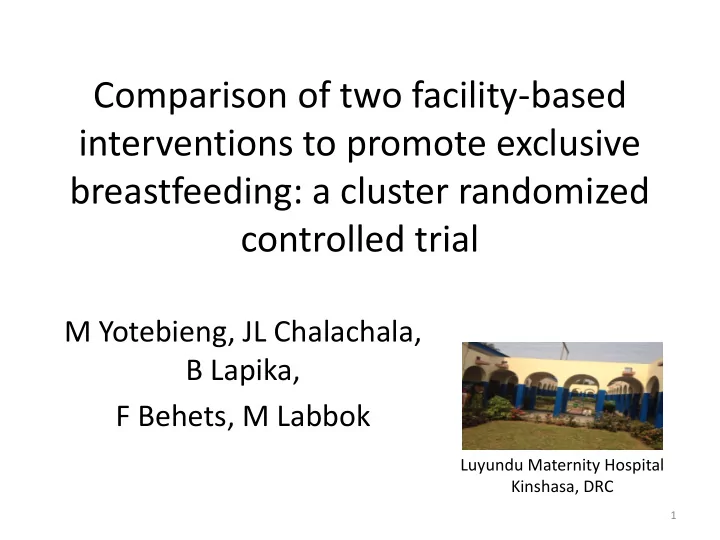

Comparison of two facility-based interventions to promote exclusive breastfeeding: a cluster randomized controlled trial M Yotebieng, JL Chalachala, B Lapika, F Behets, M Labbok Luyundu Maternity Hospital Kinshasa, DRC 1
Introduction In the Democratic Republic of Congo (DRC) rates of exclusive • breastfeeding (EBF) are low UNICEF attempted to implement the Baby-Friendly Hospital • Initiative (BFHI) in DRC to address low EBF rates in early 2000s, but successful implementation was challenging – Difficult to implement 10 th Step (fostering the establishment of breastfeeding support groups and referring mothers to them upon discharge from the hospital or clinic) – Difficult to organize external evaluations required for accreditation Study rationale • – Need to find an easier alternative to implementation of the 10 th Step – Need to evaluate BFHI implementation without accreditation 2
Objectives • To examine the effect of implementation of BFHI Steps 1-9 with or without an alternative to the 10 th step on EBF rates A mother and her 1-day old baby at Lukunga Hospital 3
Methods: Site, design & eligibility criteria • Cluster randomized controlled trial – Cluster = health facility – Health facilities matched on location, management type, # of deliveries, work load, % of mothers returning for 1 wk postpartum visit before randomization • Eligibility criteria – Single, healthy birth – Delivery in study health facility – Intention to attend well-child clinics at same health facility 4
Methods: Study Groups Control BFHI 1-9 BFHI 1-9 + • Standard of care: Group counseling on child health including BF, before vaccination • ANC and maternity ward staff trained on BFHI Steps 1-9 using WHO/UNICEF course • Well-child clinic staff trained on BFHI • Provision of BF Weighing & immunization flyer session at Luyundu Hospital 5
Methods: Interventions – BF flyer 6
Methods: Data collection & analysis • Face-to-face interviews • Comparison of baseline characteristics Interview Interview location/ – Categorical variables: time points Health visit Pearson chi-square test after delivery – Non-normally distributed 2-3 d Postpartum ward continuous variables: 1 wk Maternity clinic Wilcoxon rank sum test 6 wk Well-child clinic • Comparison of EBF rates 10 wk Well-child clinic – Generalized estimated 14 wk Well-child clinic equations accounting for cluster 18 wk Well-child clinic 24 wk Well-child clinic 7
Results: Flow diagram 44 health facilities (HFs) screened 19 HFs eligible 6 HFs randomized 2 HFs in BFHI 2 HFs in BFHI 2 HFs in control Steps 1-9 Steps 1-9 + 304 368 308 mother-infant mother-infant mother-infant pairs enrolled pairs enrolled pairs enrolled 8
Results: Baseline characteristics* Control BFHI 1-9 BFHI 1-9 + (N=310) (N=373) (N=308) Age (y), median 28 26* 26* Education (y), median 11 9* 10 Primipara (%) 27 21 26 Previous child death (%) 22 21 15* Married/Has live-in boyfriend (%) 88 89 84 Owns house she lives in (%) 48 36* 45 Electricity in house (%) 92 95 95 Piped water source (%) 81 87* 94* Flushable toilet (%) 27 49* 51* Attended ≥ 4 ANC visits (%) 71 47* 42* 9 * = Significantly different from the control group
Results: % EBF (24 h recall) Control BFHI Steps 1-9 BFHI Steps 1-9 + 98 96 100 93 93 90 87 90 81 76 80 68 70 60 51 47 45 50 40 34 30 16 14 20 10 0 2-3 d 1 wk 6 wk 14 wk 24 wk 10
Results: % EBF (24 h recall)* Control BFHI Steps 1-9 BFHI Steps 1-9 + 100 AOR: 90 2.1 (1.8, 2.5) 80 70 AOR: AOR: 60 1.3 (1.1, 1.6) 3.1 (2.3, 4.3 ) 50 40 76 AOR: 30 47 1.2 (0.7, 1.9) 45 20 34 10 16 14 0 14 wk 24 wk *Adjusted for: maternal age & education, previous child death, ownership of residence, type of toilet, and # of antenatal clinics attended 11
Conclusions • Provision of WHO/UNICEF BFHI Steps 1-9 training increased EBF rates at 14 and 24 wk • The distribution of flyers postpartum with messages addressing suboptimal BF practices seemed to lessen the effect of the BFHI training • In this context, the distribution of the study flyers was not an Mother-infant pair at effective alternative to the 10 th follow-up visit at Kitenda Step Hospital 12
Acknowledgments Participants Kinshasa School of Public Health, • • University of Kinshasa, DRC Research Team • Centre for the Coordination of Social Health Facilities: Esengo, Kinkenda, • • Science Research and Documentation Kitega, Libikisi, Lukunga, Luyindu in Africa South of the Sahara Dave Kleckner • (CERDAS), DRC Kathyrn Salisbury • Salvation Army, DRC • Kengne Villeneuve • Bureau Diocésain des Œuvres • Ruphine Mboda • Médicales de Kinshasa (BDOM) , DRC Technical Advisory Group • National Program for Nutrition • Kathryn Dewey • (PRONANUT), DRC Edye Kuyper • Bineti Vitta • Funding: the Bill & Melinda Gates Foundation to FHI 360, through the Alive & Thrive Small Grants Program managed by UC Davis 13
Recommend
More recommend